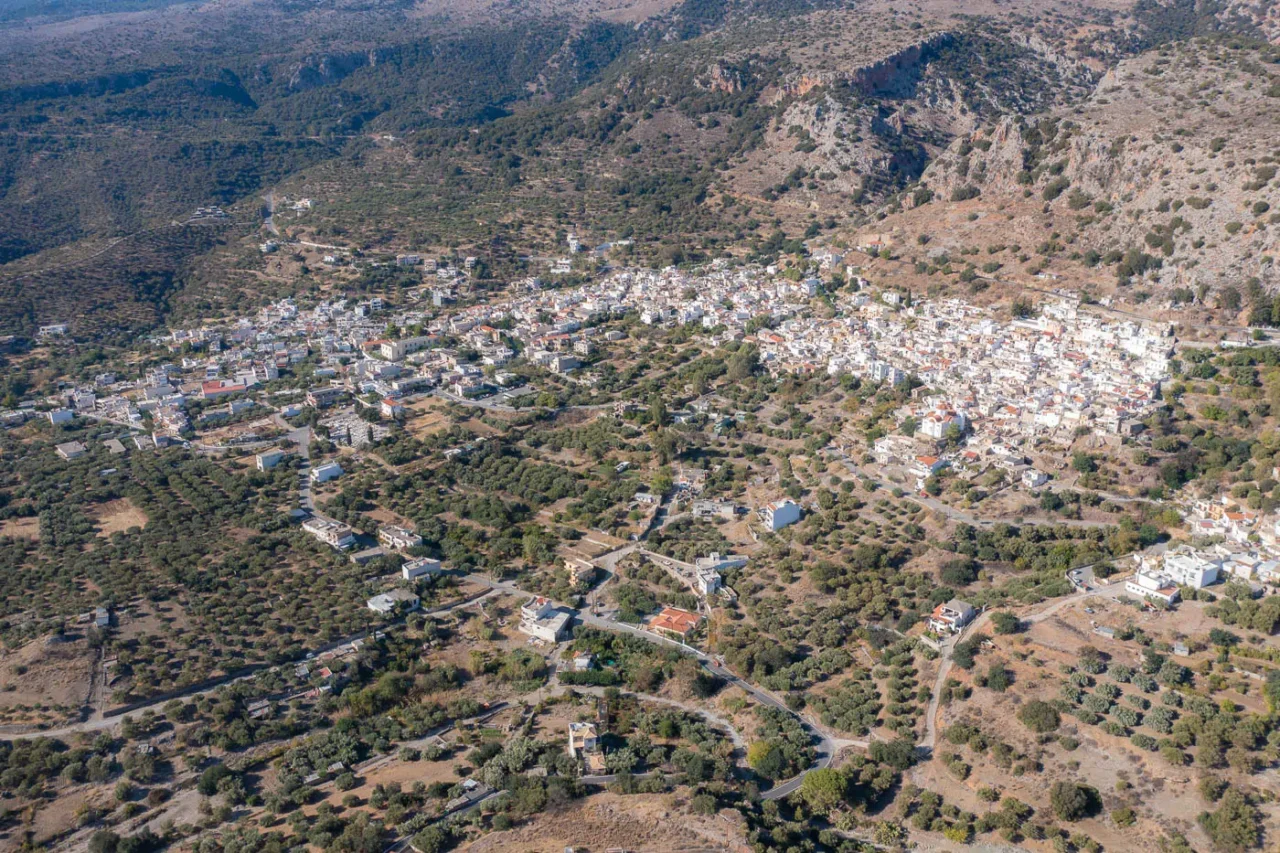
Kritsa is a traditional village and the seat of the homonymous community in the Municipality of Agios Nikolaos, in the regional unit of Lasithi. It is the center of the Mirabello area, built amphitheatrically on the foothills of Mount Kastellos at an altitude ranging from 330 to 365 meters.
Historical Overview
Kritsa stands as one of the oldest villages in Crete, retaining much of its traditional architectural character and unique urban structure. Historically, it served as the traditional agricultural and livestock center of the Agios Nikolaos region, playing a pivotal role in the development of the modern city. The inhabitants are believed to be descendants of the residents of the nearby ancient city of Lato Etera, the ruins of which lie 3 km northeast of the village in the Koutarantos area. Excavations at Lato have unearthed the agora, prytaneion, platform, and the city’s sanctuary.
The village’s history is marked by periods of prosperity and destruction. Though devastated by the Arabs in 823 CE, it was repopulated in 961 CE following its liberation by Nikephoros Phokas and flourished again during the Venetian occupation (12th-16th centuries). It was the largest village in Crete throughout the Middle Ages, comprising distinct neighborhoods mentioned separately in censuses.
In 1823, during the Cretan Revolution against the Ottomans, a significant battle took place in the Koutarantos area against Hasan Pasha. The village was burned by the Ottomans, and the battle is associated with the local legend of Rodanthi, the daughter of Kritsa’s chief priest, who fought heroically and died in the conflict.
Modern Era
In 1832, the village’s Greek school began operating, and in 1867, Kritsa became the seat of a municipality encompassing Kroustas, Prina, Kalo Chorio, Mardati, Agios Nikolaos, Mesa Lakonia, and Tapes. The grand, historic tiled-roof school next to the church of Agia Varvara was completed in 1872 and awaits restoration and reuse. In 1925, Kritsa reverted to being a community, and since 2010, it has been an integral part of the Municipality of Agios Nikolaos.
Throughout the 20th century, Kritsa actively participated in national struggles, with many of its residents serving and sacrificing their lives in conflicts such as the Balkan Wars, World War I, the Asia Minor Campaign, and World War II. During the German occupation, it was a center of resistance, collaborating with foreign partisans in the Katharo plateau area. The village endured a tragic event on November 6, 1943, when the notorious Schubertites, a German paramilitary group, attacked and killed two young local heroes, Emmanuel P. Tzanakis and Ioannis G. Koutoulakis.
Population
Year |
Population |
|---|---|
1940 |
2,572 |
1951 |
2,548 |
1961 |
2,396 |
1971 |
2,015 |
1981 |
1,910 |
1991 |
1,764 |
2001 |
1,614 |
2011 |
1,296 |
2021 |
1,291 |
Landscape and Natural Environment
Kritsa’s natural surroundings extend from the Mirabello Gulf to the Dikti mountain range, encompassing a diverse landscape of olive groves, the Havgas Gorge, an ancient oak forest, and the Katharo plateau, home to the highest settlement in Crete. The area boasts a rich flora with rare and endemic plants showcased in the “Rodanthi Museum” in Kritsa. Notable scenic spots include the Almyros wetland, the Thylakas and Roussa Limni areas, the Kritsa plain with its Byzantine church of Panagia Kera, the ancient site of Lato, and the route from Kritsa to Katharo.
Cultural and Natural Attractions
- Lato: An archaeological site 3 km from Kritsa, offering insights into ancient Cretan civilization.
- Church of Panagia Kera: A Byzantine church 1 km from Kritsa, adorned with remarkable frescoes.
- Church of Agios Ioannis Theologos: Located 2 km from Kritsa on the road to Kroustas.
- Church of Agios Georgios Kavousotis: South of the village, featuring an arcosolium and faded frescoes.
- Church of Agios Ioannis Prodromos: Situated in the village cemetery, also with frescoes.
- Church of Afendi Christos
- Rodanthi Museum of Rare and Endemic Plants
- Historical and Folklore Museum of Kritsopoula
- Kritsa Gorge: A scenic natural wonder ideal for hiking and exploration.
Settlement: Key Points
- Historical References: Kritsa’s history traces back to the Late Minoan period (13th-12th centuries BCE), with evidence of continuous human presence since then.
- Location: Situated in eastern Crete, 9 km from Agios Nikolaos and 6 km from Kroustas.
- Historical Significance: Played a crucial role in Cretan uprisings against the Ottomans, notably the 1823 battle near Lato.
- Population Data: See table below
- Current Status: A thriving village preserving its traditional architecture and way of life, attracting visitors with its cultural and natural beauty.
Access
Kritsa is 7.4 kilometers away from the town Agios Nikolaos and 9.2 kilometers away from Kalamafka


There are no comments yet.